Related Research Articles

The Dakar Rally or simply "The Dakar", formerly known as the "Paris–Dakar Rally", is an annual rally raid organised by the Amaury Sport Organisation. The rally is an off-road endurance event. The terrain that the competitors traverse is much tougher than that used in conventional rallying, and the vehicles used are typically true off-road vehicles and motorcycles, rather than modified on-road vehicles. Most of the competitive special sections are off-road, crossing dunes, mud, camel grass, rocks, and erg among others. The distances of each stage covered vary from short distances up to 800–900 kilometres (500–560 mi) per day. The rough terrain, driver fatigue, and lack of skill usually results in accidents and serious injuries.

Peugeot is a French automobile brand owned by Stellantis.
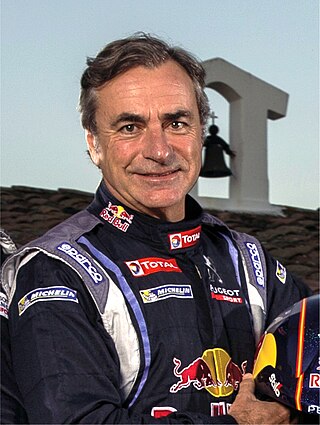
Carlos Sainz Cenamor is a Spanish rally driver. He won the World Rally Championship drivers' title with Toyota in 1990 and 1992, and finished runner-up four times. Constructors' world champions to have benefited from Sainz are Subaru (1995), Toyota (1999) and Citroën. In the 2018 season, he was one of the official drivers of the Team Peugeot Total. He received the Princess of Asturias Sports Award in 2020. Sainz founded the Acciona | Sainz XE Team to join Extreme E and competed in the first two seasons alongside Laia Sanz.
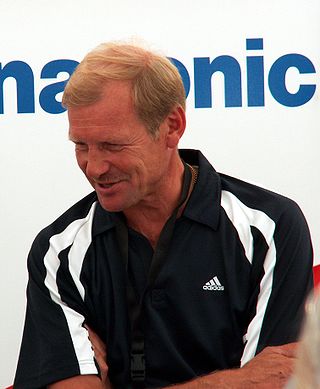
Juha Matti Pellervo Kankkunen is a Finnish former rally driver. His factory team career in the World Rally Championship lasted from 1983 to 2002. He won 23 world rallies and four drivers' world championship titles, which were both once records in the series. Both Sébastien Loeb and Sébastien Ogier have since collected more world titles, but no driver was able to repeat Kankkunen's feat of becoming a world champion with three different manufacturers until Ogier matched this achievement in 2020.

Ari Pieti Uolevi Vatanen is a Finnish rally driver turned politician and a Member of the European Parliament (MEP) from 1999 to 2009. He won the World Rally Championship drivers' title in 1981 and the Paris Dakar Rally four times. In addition, he won the 1997 FIA World Cup for Cross-Country Rallies.

Jean Henri Todt is a French motor racing executive and former rally co-driver. He was previously director of Peugeot Talbot Sport and then Scuderia Ferrari Formula 1 team principal, before being appointed chief executive officer of Ferrari from 2004 to 2008. From 2009 to 2021 he served as the ninth president of the Fédération Internationale de l'Automobile (FIA).
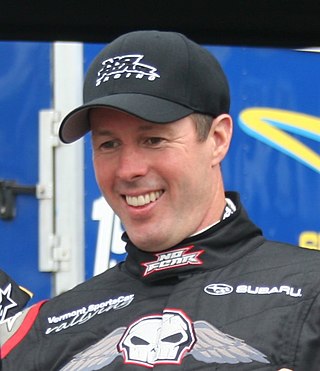
Colin Steele McRae,, was a rally driver from Scotland. He was the 1991 and 1992 British Rally Champion, and in 1995 became the first Scottish driver to win the World Rally Championship Drivers' title.

Group B was a set of regulations for grand touring (GT) vehicles used in sports car racing and rallying introduced in 1982 by the Fédération Internationale de l'Automobile (FIA). Although permitted to enter a GT class of the World Sportscar Championship alongside the more popular racing prototypes of Group C, Group B are commonly associated with the international rallying scene during 1982 to 1986 in popular culture, when they were the highest class used across rallying, including the World Rally Championship, regional and national championships.

Eliseo Salazar Valenzuela is a Chilean former racing driver, who competed in Formula One from 1981 to 1983. Salazar remains the only Chilean driver to compete in Formula One.

Timo Salonen is a Finnish former rally driver who won the 1985 World Rally Championship season for Peugeot. It was commented of him that he stood out from other drivers, because he was overweight, wore thick glasses and smoked heavily, but still remained one of the fastest and most competitive drivers in the sport. He was also known for his relaxed attitude and for his habit of steering his rally car with one hand only. These factors led to the nickname Löysä ("Slack"). With his 11 rally wins he remained the most successful driver of Group B era (1983–1986) of WRC.
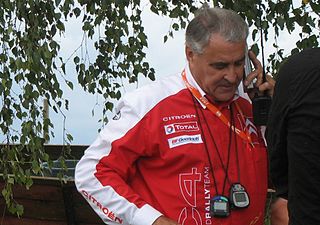
Guy Fréquelin is a French former rally and sports car driver.
Peugeot Sport is the department of French carmaker Peugeot responsible for motorsport activities.

1987 Dakar Rally also known as the 1987 Paris–Dakar Rally was the 9th running of the Dakar Rally event. The rally was won by 1981 world rally champion, Ari Vatanen. Cyril Neveu won his fifth motorcycle title after Hubert Auriol broke both ankles in a fall and retired. Jan de Rooy won the truck title, 11th place overall.

1988 Dakar Rally also known as the 1988 Paris–Dakar Rally was the 10th running of the Dakar Rally event. 311 cars, 183 motorcycles, and 109 trucks started the rally. The rally was won by Juha Kankkunen, the motorcycle category was won by Edi Orioli, and the truck category was won by Karel Loprais on a Tatra 815. The event was marred by the death of six people, three participants, a mother and child killed in Mauritania when a camera car ran into a group of spectators, and a 10-year-old girl killed crossing the road in Mali.

1990 Dakar Rally also known as the 1990 Paris–Dakar Rally was the 12th running of the Dakar Rally event. 465 competitors started from La Défense. The rally was won by 1981 world rally champion, Ari Vatanen, for the third time in four years. The motorcycle class was won by Edi Orioli.
1991 Dakar Rally also known as the 1991 Paris–Dakar Rally was the 13th running of the Dakar Rally event. The rally was won by 1981 world rally champion, Ari Vatanen, for the third successive time and for the fourth time in five years. Stéphane Peterhansel won the motorcycle category.
The 2003 Dakar Rally, also known as the 2003 Telefónica-Dakar Rally, was the 25th running of the Dakar Rally event. The rally began on 1 January 2003 at Marseille in France and finished at Sharm el-Sheikh in Egypt on 19 January, with the course crossing North Africa.
2004 Dakar Rally also known as the 2004 Paris-Dakar Rally was the 26th running of the Dakar Rally event. The rally started in the Auvergne region of France, passing through Morocco, Western Sahara, Mauritania and Mali, and finishing Dakar in Senegal. This was the last time the rally ever visited France. The rally was won by the French team of Stéphane Peterhansel and Jean-Paul Cottret in a Mitsubishi; while the motorcycle class was won by Nani Roma of Spain on a KTM and the trucks class was won by Russians Vladimir Chagin, Semen Yakubov and Sergey Savostin in a Kamaz.

2005 Dakar Rally also known as the 2005 Paris-Dakar Rally was the 27th running of the Dakar Rally event. The 2005 event was 5,565 miles (8,956 km) long, began in Barcelona on 31 December 2004 and passed through Morocco, Western Sahara, Mauritania and Mali before ending at Dakar in Senegal on 16 January 2005. The course was shorter than in 2004 but was more challenging. A record number of competitors, 696 cars, motorbikes and trucks in total, entered the rally.
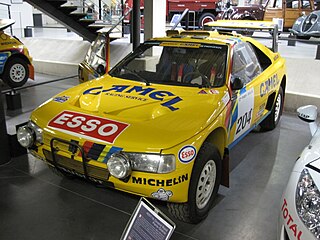
The Peugeot 405 Turbo 16 is a coupé derived from the Peugeot 405 and the Peugeot 205 Turbo 16, built by Peugeot Talbot Sport for African rally raids in 1988. Driven by Ari Vatanen, the four wheel drive car won the Paris Dakar rally in 1989 and 1990. It won the Pikes Peak International Hill Climb in 1988 setting a record-breaking time of 10 minutes and 47 seconds in the hands of Vatanen. Footage from Vatanen's run was used to create the short film Climb Dance.
References
- 1 2 "History of Dakar – Retrospective 1979–2007" (PDF). Dakar. 2009. Archived from the original (PDF) on 8 July 2011. Retrieved 15 February 2024.
- ↑ Nugnes, Franco (2 October 2018). "Todt: 'E' giusto non nascondere un gioco di squadra: meglio dire la verità'". Motorsport.com (in Italian). Retrieved 15 February 2024.
- ↑ Guidotti, Maria (17 January 2021). "'Nel deserto della Dakar con una monetina ho scoperto la saggezza'". Il Giornale (in Italian). Retrieved 15 February 2024.
- ↑ "Vatanen on comeback trail". BBC Sport. 4 November 2002. Retrieved 15 February 2024.